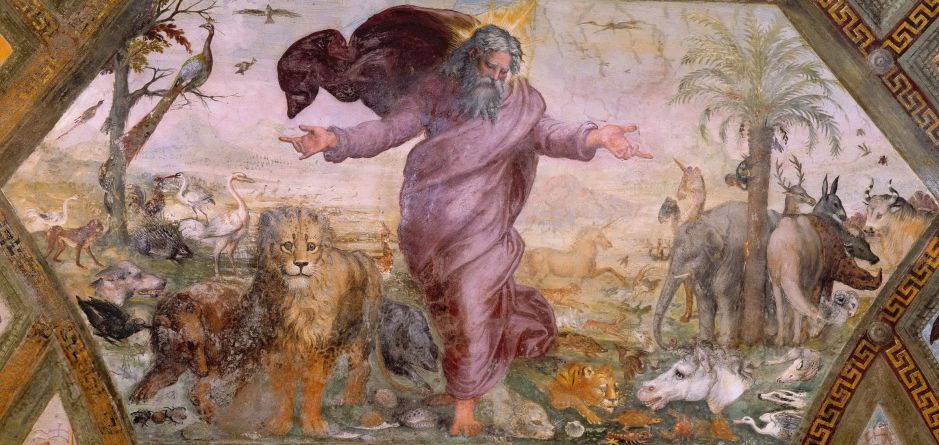Each cultural tradition has its own myths on the origin and history of animals, and several have been depicted in great European paintings. This article looks at some of the best.

Raphael’s sequence of paintings in the Loggia of the Palazzo Apostolico in the Vatican naturally starts with the Creation, told in four scenes in the first bay, ending with The Creation of the Animals. God the Creator walks among a marvellous collection of animals and birds. Notable among these are a unicorn, below God’s left hand, and an early image of a rhinoceros at the right. Although the latter may seem novel, rhinos first appeared in European paintings before 30,000 BCE, and in 1515 Albrecht Dürer made a woodcut of one on the basis of verbal descriptions. The large dark object to the left of God’s head isn’t a Jovian eagle, but God’s cloak blowing behind him in the wind.

When Raphael was working on that painting, Jacopo Tintoretto was born. He went on to paint his own cycle of scenes from the Old Testament for the Scuola della Trinità in Venice in 1550-53. The first of these is the Creation of the Animals, in which God flies along as he is creating pairs of different species of bird, fish, and animal, from cormorants to rabbits. At the upper right corner is the unmistakable head of a white unicorn, suggesting that Tintoretto also believed that they were real rather than legendary.

About a century later, Jan Brueghel the Younger became equally imaginative when painting the Creation of Adam in Paradise. He includes a strange-looking giraffe and a brilliant white unicorn in the distance, together with many real creatures.

Cornelis van Haarlem showed his cavalcade of animals not in the creation, but with The Fall of Man (1592), whose many different species are seen in the Garden of Eden. These include familiar species such as monkey, dog, fox, sheep, cat, frog, and snail.
The most famous Judeo-Christian event featuring animals was the Great Flood, in which a breeding pair of each of the animals and birds was preserved in Noah’s ark.

This painting by an unknown artist of The Great Flood (c 1450-1499) features Noah’s Ark, with its rich collection of wildlife, at the lower left. This is floating in the remains of a populous town, whose inhabitants fill the forming lake.
Unlike the great floods of classical mythology, this spared the animals, as the works of God, and ended with them coming out, two by two, to repopulate the earth. At that, Noah gave thanks to God, who made a covenant with the remains of humankind, signified in the rainbow.

Domenico Morelli captures this in his undated Noah’s Thanksgiving after Leaving the Ark.
Some European paintings don’t appear to fit convention, though, prominent among them being Hieronymus Bosch’s Garden of Earthly Delights (c 1495-1505).

Its centre panel shows a rolling deer park with lakes, which is overrun by a dense mass of naked men and women, and bizarre objects. Parading in a circle is an extraordinary collection of animals.
Classical myth has several different animal cavalcades to offer.

Giulio Romano’s fresco of a Tribute to Apollo from 1526-28, in the Palazzo del Tè, in Mantua, Italy, also includes stranger and more mythical beasts at the left in the far distance.

Briton Rivière’s Aphrodite from 1902 is perhaps the only painting of the goddess of erotic love which shows her fully clothed, and not in the least bit erotic. Instead, she reaches up towards a white dove, one of her more ancient associations, and leads a group of pairs of animals, almost like Noah. His allusion to physical love is thus indirect and procreative rather than sensual.
My favourite myth, though, is that of Orpheus and the animals, in which the greatest of all poets and musicians charmed the birds and animals.

Paulus Potter’s Orpheus and Animals from 1650 shows a wide range of different animal species, some of which were still not well-known at the time. These include a Bactrian camel (two humps), donkey, cattle, ox, wild pig, sheep, dog, goat, rabbit, lions, dromedary (one hump), horse, elephant, snake, deer, lizard, wolf, monkey and unicorn.

In 1930, Anita Rée was commissioned to paint a mural for a girls’ secondary school in Hamburg, Germany, which she completed in October 1931: her joyous Orpheus and the Animals has been preserved, and is now part of a ballet school. This image shows but part of it, with Orpheus riding a mythical beast over the lintel of the door.

